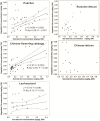Transfer of cadmium from soil to vegetable in the Pearl River Delta area, South China
- PMID: 25247431
- PMCID: PMC4172568
- DOI: 10.1371/journal.pone.0108572
Transfer of cadmium from soil to vegetable in the Pearl River Delta area, South China
Abstract
The purpose of this study was to investigate the regional Cadmium (Cd) concentration levels in soils and in leaf vegetables across the Pearl River Delta (PRD) area; and reveal the transfer characteristics of Cadmium (Cd) from soils to leaf vegetable species on a regional scale. 170 paired vegetables and corresponding surface soil samples in the study area were collected for calculating the transfer factors of Cadmium (Cd) from soils to vegetables. This investigation revealed that in the study area Cd concentration in soils was lower (mean value 0.158 mg kg(-1)) compared with other countries or regions. The Cd-contaminated areas are mainly located in west areas of the Pearl River Delta. Cd concentrations in all vegetables were lower than the national standard of Safe vegetables (0.2 mg kg(-1)). 88% of vegetable samples met the standard of No-Polluted vegetables (0.05 mg kg(-1)). The Cd concentration in vegetables was mainly influenced by the interactions of total Cd concentration in soils, soil pH and vegetable species. The fit lines of soil-to-plant transfer factors and total Cd concentration in soils for various vegetable species were best described by the exponential equation (y = ax(b)), and these fit lines can be divided into two parts, including the sharply decrease part with a large error range, and the slowly decrease part with a low error range, according to the gradual increasing of total Cd concentrations in soils.
Conflict of interest statement
Figures









References
-
- Singh BR, McLaughlin MJ (1999) Cadmium in Soils and Plants. In: Mclaughlin M., Singh BR, editors. Cadmium in soils and plants. Boston: Kluwer Academic. 357–367.
-
- Tudoreanu L, Phillips CJC (2004) Modeling cadmium uptake and accumulation in plants. Adv Agron 84: 121–157 10.1016/S0065-2113(04)84003-3 - DOI
-
- Singh A, Sharma RK, Agrawal M, Marshall FM (2010) Risk assessment of heavy metal toxicity through contaminated vegetables from waste water irrigated area of Varanasi, India. Trop Ecol 51: 375–387.
-
- WHO (1992) Cadmium: Environmental Health Criteria, 134. Geneva.
-
- Chlopecka A, Bacon JR, Wilson MJ, Kay J (1996) Forms of Cadmium, Lead, and Zinc in Contaminated Soils from Southwest Poland. J Environ Qual 25: 69 10.2134/jeq1996.00472425002500010009x - DOI
Publication types
MeSH terms
Substances
LinkOut - more resources
Full Text Sources
Other Literature Sources
Miscellaneous

